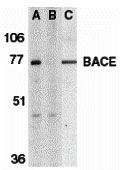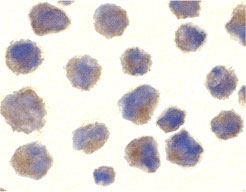BACE Antibody
- 产品详情
- 实验流程
- 背景知识
Application
| WB, ICC, E |
|---|---|
| Primary Accession | P56817 |
| Other Accession | AF190725, 6118538 |
| Reactivity | Human, Mouse |
| Host | Rabbit |
| Clonality | Polyclonal |
| Isotype | IgG |
| Calculated MW | 55764 Da |
| Concentration (mg/ml) | 1 mg/mL |
| Conjugate | Unconjugated |
| Application Notes | BACE can be used for detection of BACE by Western blot at 1 µg/mL. Antibody can also be used for immunocytochemistry starting at 10 µg/mL. |
| Gene ID | 23621 |
|---|---|
| Other Names | BACE Antibody: ASP2, BACE, HSPC104, KIAA1149, Beta-secretase 1, Aspartyl protease 2, ASP2, beta-site APP-cleaving enzyme 1 |
| Target/Specificity | BACE1; |
| Reconstitution & Storage | BACE antibody can be stored at 4℃ for three months and -20℃, stable for up to one year. As with all antibodies care should be taken to avoid repeated freeze thaw cycles. Antibodies should not be exposed to prolonged high temperatures. |
| Precautions | BACE Antibody is for research use only and not for use in diagnostic or therapeutic procedures. |
| Name | BACE1 (HGNC:933) |
|---|---|
| Synonyms | BACE, KIAA1149 |
| Function | Responsible for the proteolytic processing of the amyloid precursor protein (APP). Cleaves at the N-terminus of the A-beta peptide sequence, between residues 671 and 672 of APP, leads to the generation and extracellular release of beta-cleaved soluble APP, and a corresponding cell-associated C-terminal fragment which is later released by gamma-secretase (PubMed:10656250, PubMed:10677483, PubMed:20354142). Cleaves CHL1 (By similarity). |
| Cellular Location | Cell membrane; Single-pass type I membrane protein Golgi apparatus, trans-Golgi network. Endoplasmic reticulum. Endosome. Cell surface. Cytoplasmic vesicle membrane; Single-pass type I membrane protein. Membrane raft {ECO:0000250|UniProtKB:P56818}. Lysosome. Late endosome. Early endosome. Recycling endosome. Cell projection, axon {ECO:0000250|UniProtKB:P56818}. Cell projection, dendrite {ECO:0000250|UniProtKB:P56818}. Note=Predominantly localized to the later Golgi/trans-Golgi network (TGN) and minimally detectable in the early Golgi compartments. A small portion is also found in the endoplasmic reticulum, endosomes and on the cell surface (PubMed:11466313, PubMed:17425515). Colocalization with APP in early endosomes is due to addition of bisecting N-acetylglucosamine which blocks targeting to late endosomes and lysosomes (By similarity) Retrogradly transported from endosomal compartments to the trans-Golgi network in a phosphorylation- and GGA1- dependent manner (PubMed:15886016). {ECO:0000250|UniProtKB:P56818, ECO:0000269|PubMed:11466313, ECO:0000269|PubMed:15886016, ECO:0000269|PubMed:17425515} |
| Tissue Location | Expressed at high levels in the brain and pancreas. In the brain, expression is highest in the substantia nigra, locus coruleus and medulla oblongata. |
For Research Use Only. Not For Use In Diagnostic Procedures.
Provided below are standard protocols that you may find useful for product applications.
BACKGROUND
BACE Antibody: Accumulation of the amyloid-beta (Abeta) plaque in the cerebral cortex is a critical event in the pathogenesis of Alzheimer's disease. Abeta peptide is generated by proteolytic cleavage of the beta-amyloid protein precursor (APP) at beta- and gamma-sites by two proteases. APP is first cleaved by beta-secretase, producing a soluble derivative of the protein and a membrane anchored 99-amino acid carboxy-terminal fragment (C99). The C99 fragment serves as substrate for gamma-secretase to generate the 4 kDa amyloid-beta peptide, which is deposited in the brains of all suffers of Alzheimer's disease. The long-sought beta-secretase was recently identified by several groups independently and designated beta-site APP cleaving enzyme (BACE) and aspartyl protease 2 (Asp2). BACE/Asp2 is a novel transmembrane aspartic protease and colocalizes with APP.
REFERENCES
Vassar R, Bennett BD, Babu-Khan S, et al. β-secretase cleavage of Alzheimer's amyloid precursor protein by the transmembrane aspartic protease BACE. Science 1999;286:735-41
Hussain I, Powell D, Howlett DR , et al. Identification of a novel aspartic protease (Asp 2) as β-secretase. Mol Cell Neurosci 1999;14:419-27
Yan R, Bienkowski MJ, Shuck ME, et al. Membrane-anchored aspartyl protease with Alzheimer's disease β-secretase activity. Nature 1999;402:533-7
Sinha S, Anderson JP, Barbour R, et al. Purification and cloning of amyloid precursor protein β-secretase from human brain. Nature 1999;402:537-40 (WD0500)
终于等到您。ABCEPTA(百远生物)抗体产品。
点击下方“我要评价 ”按钮提交您的反馈信息,您的反馈和评价是我们最宝贵的财富之一,
我们将在1-3个工作日内处理您的反馈信息。
如有疑问,联系:0512-88856768 tech-china@abcepta.com.























 癌症的基本特征包括细胞增殖、血管生成、迁移、凋亡逃避机制和细胞永生等。找到癌症发生过程中这些通路的关键标记物和对应的抗体用于检测至关重要。
癌症的基本特征包括细胞增殖、血管生成、迁移、凋亡逃避机制和细胞永生等。找到癌症发生过程中这些通路的关键标记物和对应的抗体用于检测至关重要。 为您推荐一个泛素化位点预测神器——泛素化分析工具,可以为您的蛋白的泛素化位点作出预测和评分。
为您推荐一个泛素化位点预测神器——泛素化分析工具,可以为您的蛋白的泛素化位点作出预测和评分。 细胞自噬受体图形绘图工具为你的蛋白的细胞受体结合位点作出预测和评分,识别结合到自噬通路中的蛋白是非常重要的,便于让我们理解自噬在正常生理、病理过程中的作用,如发育、细胞分化、神经退化性疾病、压力条件下、感染和癌症。
细胞自噬受体图形绘图工具为你的蛋白的细胞受体结合位点作出预测和评分,识别结合到自噬通路中的蛋白是非常重要的,便于让我们理解自噬在正常生理、病理过程中的作用,如发育、细胞分化、神经退化性疾病、压力条件下、感染和癌症。







